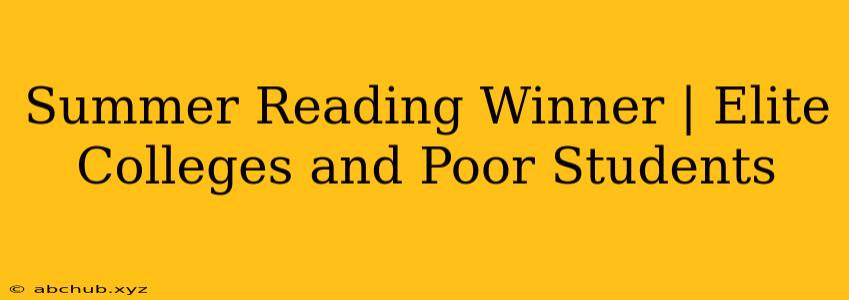The summer reading list. A rite of passage for high school students eagerly anticipating college life, this tradition serves as a bridge between the academic year and the hallowed halls of higher education. Yet, for underprivileged students, this seemingly innocuous ritual can present a formidable hurdle. Access to resources, including books, quiet spaces, and even the time itself, can be scarce, putting them at a distinct disadvantage before they even step foot on campus.
The "Summer Reading Gap" and Its Consequences
The "summer reading gap," a term coined to describe the disparity in educational experiences during the summer months, has far-reaching implications. While privileged students may engage in enriching activities like volunteering, internships, or travel, underprivileged students often find themselves caught in a cycle of stagnating or even regressing academic progress. This can manifest in a number of ways:
- Academic Performance: Students who lack access to summer learning opportunities may fall behind their peers in terms of knowledge and skills, creating a disadvantage in challenging college coursework.
- Confidence and Motivation: Feeling unprepared or out of sync with their classmates can lead to diminished self-confidence and a decrease in academic motivation.
- Social Integration: The inability to engage in activities common among peers can lead to feelings of isolation and difficulty forming social connections.
Bridging the Gap: Initiatives and Strategies
Recognizing the critical need to address the "summer reading gap," institutions and organizations have begun to implement innovative solutions. These initiatives encompass a range of approaches, from direct financial assistance to comprehensive support programs:
1. Providing Access to Books and Digital Resources
- Book Lending Programs: Libraries, community centers, and even schools themselves can establish lending programs that provide underprivileged students with access to summer reading selections.
- E-book Platforms: Digital platforms like Overdrive or Hoopla offer free access to a vast library of books, eliminating the need for physical copies.
- Textbooks and Course Materials: Ensuring access to relevant textbooks and course materials can help students stay abreast of academic expectations.
2. Facilitating Learning Environments
- Summer Bridge Programs: Intensive programs designed to bridge the knowledge gap and prepare students for the academic rigor of college.
- Mentorship and Tutoring: Pairing underprivileged students with experienced mentors or tutors can provide academic guidance and support.
- Study Spaces and Quiet Zones: Creating accessible study spaces in community centers or libraries can provide a conducive environment for focused learning.
3. Addressing Socioeconomic Barriers
- Financial Aid and Scholarships: Making summer programs and resources financially accessible through scholarships and grants.
- Transportation Assistance: Providing transportation assistance to students who lack access to reliable transportation can enable them to participate in educational opportunities.
- Childcare Support: Offering childcare support can alleviate the financial burden of working parents and allow their children to focus on learning.
The Role of Elite Colleges: Beyond Admission
While the responsibility to bridge the "summer reading gap" rests on society as a whole, elite colleges have a unique and crucial role to play. Their resources, prestige, and influence can make a significant impact in fostering a more equitable educational landscape.
Here's how elite colleges can go beyond simply admitting underprivileged students:
- Targeted Summer Programs: Designing and offering specific summer programs tailored to the needs of underprivileged students. These programs can provide academic enrichment, skills development, and cultural experiences.
- Early Intervention Initiatives: Engaging with underprivileged students at a younger age, fostering academic interest, and providing resources to support their academic journey.
- Faculty Mentorship: Establishing mentorship programs that pair underprivileged students with faculty members who can provide guidance, support, and networking opportunities.
- Community Partnerships: Collaborating with local community organizations to create pathways for underprivileged students to access college preparatory programs and resources.
- Financial Aid Transparency: Providing clear and comprehensive information on financial aid packages, eliminating confusion and ensuring equitable access to support.
- Diversity and Inclusion Training: Implementing mandatory training for faculty and staff on diversity and inclusion, fostering a welcoming and supportive environment for underprivileged students.
Breaking Down Barriers: A Call to Action
Addressing the "summer reading gap" requires a collective effort. By taking proactive steps to bridge the gap, we can create a more equitable and inclusive educational system that empowers all students to reach their full potential.
Here's a breakdown of key initiatives and their impact on leveling the playing field:
| Initiative | Impact |
|---|---|
| Providing Access to Books and Digital Resources | Increases access to essential reading materials, fostering academic engagement and knowledge acquisition. |
| Facilitating Learning Environments | Creates conducive spaces and supports for focused learning, enhancing academic performance and confidence. |
| Addressing Socioeconomic Barriers | Eliminates financial and logistical barriers to education, ensuring equitable access to opportunities. |
| Targeted Summer Programs | Provides intensive academic enrichment, skills development, and cultural experiences, bridging the knowledge gap and preparing students for college. |
| Early Intervention Initiatives | Fosters academic interest at a young age, creating a foundation for success and ensuring equitable access to educational resources. |
| Faculty Mentorship | Offers individualized guidance, support, and networking opportunities, fostering academic growth and confidence. |
| Community Partnerships | Leverages the resources and expertise of local organizations to create pathways for underprivileged students to access college preparatory programs. |
| Financial Aid Transparency | Eliminates confusion and ensures equitable access to financial aid, making college financially attainable for underprivileged students. |
| Diversity and Inclusion Training | Fosters a welcoming and inclusive environment for underprivileged students, promoting their sense of belonging and academic success. |
Keywords: Summer Reading, Elite Colleges, Underprivileged Students, Summer Reading Gap, Equity, Access, Resources, Programs, Initiatives, Mentorship, Community Partnerships, Financial Aid, Diversity, Inclusion
Related Keywords: College Admission, Educational Disparities, Socioeconomic Inequality, Opportunity Gaps, Academic Success, Social Mobility, Student Support, Higher Education, Bridge Programs, Summer Learning, Library Access, Digital Literacy, Financial Aid Transparency, Inclusive Environments, Social Justice, Educational Equity, College Readiness.
